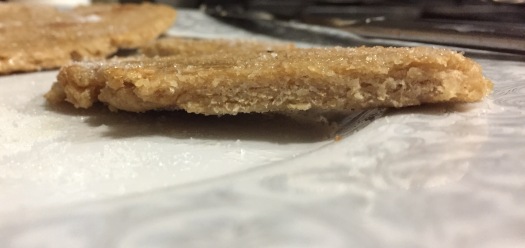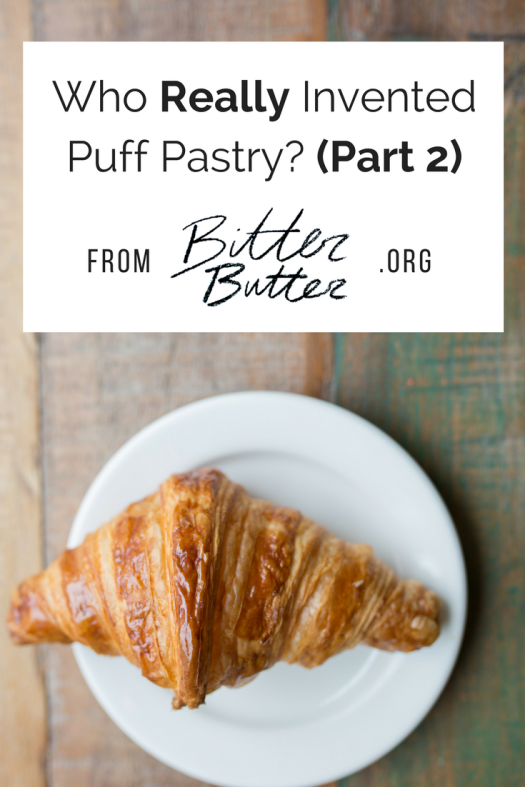And we’re back! If you missed Part 1 of “Who Really Invented Puff Pastry,” click here to read it and get some intriguing backstory on Claudius Gele, a guy that Google insists invented puff pastry, but (spoiler!) didn’t actually exist.
So why has this false “Claudius Gele” story stuck around?
This is total speculation on my part, but why do any of these stories stick around? People like to believe that bumblebees shouldn’t be able to fly, or that Albert Einstein was a C-student, because it gives you a sense of justice or comeuppance or whatever.
The Claude Lorrain story probably kept circling around because it’s intriguing to think that someone who’s great at one thing (i.e. landscape painting) might have also been a genius at another, completely separate thing. A double-threat, if you will.

But this vague story can be twisted to fit whatever worldview you favor. In one version, an amazing painter was ALSO the inventor of puff pastry, and wow, what a Cool Multitalented Dude.
In another (probably the most correct one), a kid was sort-of okay at baking pastries, but then found his real talents elsewhere, in landscape painting.
In the Claudius Gele story, some nice dude, in a burst of empathy for his #poorsickfather invents an ENTIRELY new way to bake dough that CONFOUNDS and amazes the so-called expert at the time.
So whether you’re someone who likes to hear about multitalented people, or people flailing a bit before finding their niche, or people totally upsetting the status quo for charmingly down-to-earth reasons (i.e. baking a loaf for their sick father, not baking a loaf To Change French Cuisine As We Know It)–there’s something in some version of this story to hang on to.
That stickiness, combined with the prevalence the myth built through the sheer number of times the Claudius Gele story was copied-and-pasted, is how an untruth becomes a truth.
So what do we actually know about who REALLY invented puff pastry?
First of all, puff pastry is much older than the above myth would have you believe. Like, four whole centuries older.
This recipe is anonymous, but comes from a 13th-century medieval Arab cookbook written in Moorish Spain (emphasis mine):

Musammana
“Take pure semolina or wheat flour and knead a stiff dough without yeast. Moisten it little by little and don’t stop kneading it [p. 63, verso] until it relaxes and is ready and is softened so that you can stretch a piece without severing it. Then put it in a new frying pan on a moderate fire. When the pan has heated, take a piece of the dough and roll it out thin on marble or a board. Smear it with melted clarified butter or fresh butter liquified over water. Then roll it up like a cloth until it becomes like a reed. Then twist it and beat it with your palm until it becomes like a round thin bread, and if you want, fold it over also. Then roll it out and beat it with your palm a second time until it becomes round and thin. Then put it in a heated frying pan after you have greased the frying pan with clarified butter, and whenever the clarified butter dries out, moisten [with butter] little by little, and turn it around until it binds, and then take it away and make more until you finish the amount you need. Then pound them between your palms[167] and toss on butter and boiling honey. When it has cooled, dust it with ground sugar and serve it.”
If you’re not familiar with puff pastry, you might’ve missed the mic drop, so let me pick it up and explain you the similarity.
Puff pastry is made by rolling dough out thin, putting fat on top of it (typically a rectangle of chilled butter or, in this case, liquified butter), and continuing to fold and roll the dough so you get, mathematically, HUNDREDS of layers of dough-butter-dough-butter-dough.

That’s what’s happening here, absolutely. Dough, brush butter on top, and then roll up the dough (lots of layers) and TWIST the dough (more layers) and then fold it, and repeat the process.
The Musammana recipe was translated from Arabic by Charles Perry, co-founder of the Culinary Historians of Southern California. In an LA Times article from 1992 (almost 10 years before the Claudius Gele myth first appeared online!), Perry asserts that puff pastry emerged in Moorish Spain in the 13th century:
“What clinches Moorish Spain as the home of puff pastry is that this was not the only way of making layered pastry given in the 13th-Century books. Moorish Spain in fact had an obsessive interest in the whole topic of layering. Thin sheets of dough were stacked on top of each other and baked, or twisted together and inflated before baking. Or a sheet of dough would be fried on both sides, another raw sheet would be stuck to it and the resulting “sandwich” would be fried, and then a third, fourth and fifth sheet would be cooked onto the structure, building up a sort of layered cake.”
I’m in the process of tracking down “Superfluity of the Table,” which seems to be a book the internet has forsaken entirely. Perry has another article where he talks about three Arabic cookbooks, which I mention as “further reading” and also “Look, this guy isn’t just throwing out cookbook names willy-nilly, and I’m sure Superfluity of the Table exists somewhere.”
There is also, allegedly, a “charter” written by Bishop Robert of Amiens in 1311 that describes flaky puff pastries. I haven’t found this charter, so there are no guarantees this is true (or that Bishop Robert of Amiens was a person), but I’ll keep you updated. And regardless, that’s in the 14th century, so it’s still not older than the Musammana recipe.
There’s what looks to be a modern-day version of Musammana called Msemmen, but it skips the layering (namely the twisting and folding), which is interesting. Does that mean this method of puff-pastry died out, or is it still around today under a different name? We’re over 3,000 words here, so that’s a question for a future blog post.
But still left in this blog post–I totally made some Musammana. With mixed results!
Musammana: My 2017 Adaptation

This recipe makes 4-5 pastries that are roughly hand-size.
Musammana Ingredients
- 1 cup whole wheat flour (or semolina, but I used whole wheat flour)
- 8 tablespoons water
- 4 tablespoons clarified butter
- 4 tablespoons honey
- Sugar to coat
Musammana Directions
- Dump the flour in a mixing bowl. Add the water to the flour 1 tablespoon at a time, and mix with your hands until it becomes a stiff dough.

- Form it into a ball and start kneading it. (If you’re not sure how to knead something, watch this video.)
- The dough is going to be really stiff the whole time you’re kneading it. You want to keep kneading it until it relaxes–until it’s warm and elastic, and you can stretch it without the dough immediately breaking in two. This will take a while–around 10 minutes of solid kneading.
- Once your dough is ready, break off a cake-pop-sized piece of dough, roll it into a ball, and roll it out as thin as you can on a floured counter.

- Brush the dough with your clarified butter. (For instructions on clarifying butter, try these stovetop instructions, and if you accidentally make brown butter like I did, try this microwave method.)
- Roll the dough up tightly, like you’re making the world’s smallest cinnamon rolls.

- Twist the dough like Anastasia twists her program while waiting to meet her grandmother.
- Coil it around itself and use your palms to flatten it into a round-ish pastry. Fold it over a couple times and flatten it again. This is a semi-improvisational step–repeat twisting, folding, and flattening a couple more times if you like.
- Heat up a frying pan over medium heat. Coat it with clarified butter.
- When the pan is hot, add the flattened dough. Cook until one side is golden brown, then flip it over and repeat.
- Remove the fried dough from heat. Brush both sides with “boiling honey.” (Microwave your honey for 30 seconds to liquefy it and make it easier to brush.)
- Once your pastry cools, coat both sides of the pastry with sugar. (You can do this by tossing it in a plate of sugar.)
Musammana Review
So first of all, there were definitely layers–but they weren’t light and flaky. Which maybe isn’t super surprising. I mean, the dough is literally wheat and water. It was definitely tasty, though fried dough layered with butter and coated in honey and sugar is, like, GUARANTEED to be at least a little bit tasty.

You’d be hard-pressed to find someone who looked at a musammana pastry and said “YES! Wow, this is definitely a medieval version of croissant dough.” But–important–THAT DOESN’T MEAN IT ISN’T.
First, maybe I’m doing it wrong. Maybe if I had a 13th-century Moorish ghost helper they’d be all “OMG what? No that dough is WAY too thick. No no here, you need to STRETCH it, you don’t just–okay hang on, you’re not frying it for long enough. Wait that is not enough butter. You know what? Why don’t I just…” and then they’d zap the spatula out of my hand with their ghostly powers.
Second, it’s unlikely that a cooking technique like puff pastry just appeared one day. It probably, like most things, evolved gradually out of a long line of layered pastries. Is this recipe part of that evolution? Yes, absolutely.
Conclusion
I still have so many questions. But the main one is I want to know so much more about the cooks in 13th-century Moorish Spain that were making this dough.
Who were the faces in the kitchen that were obsessed with layering? Women? Men? Children? Were they Moorish or Spanish (or both)? What kinds of conversations happened in those kitchens? How were these cooks seen by society–were they low-status, or were they revered and respected for their dough wizardry?
And hold up, they were almost definitely making puff pastry on a HEARTH, yes? YEAH. Don’t YOU want to know more about the superheroes who made PUFF PASTRY over a FIRE, instead of with a fridge and a perfectly-calibrated oven?
Till next time.
Featured photo credit: Kaley Dykstra on Unsplash

